Do you have a face tattoo that you no longer want? If so, you’re not alone. Millions of people have tattoos that they’ve grown to regret, and many of them are located on their face. If you’re looking to remove a face tattoo, this article is here to help. We’ll provide you with the ultimate guide to erasing your ink, including the various methods available and the pros and cons of each. So, if you want to learn how to remove a face tattoo, keep reading!
Contents
Types of Face Tattoos

Permanent Tattoos
Permanent tattoos are the most common type of face tattoos. These tattoos are made using an ink-based pigment that is injected deep into the skin. This type of tattoo is also the most difficult to remove, as the ink has been embedded into the dermis layer of the skin. How to remove permanent face tattoos requires several treatments with laser tattoo removal.
Semi-Permanent Tattoos
Semi-permanent tattoos, also known as temporary tattoos, are made using a different type of pigment that is not injected as deep into the skin. This type of face tattoo is easier to remove than a permanent tattoo, but it still requires several treatments with laser tattoo removal. How to remove semi-permanent face tattoos usually takes fewer treatments than a permanent tattoo.
Who Should Remove a Face Tattoo
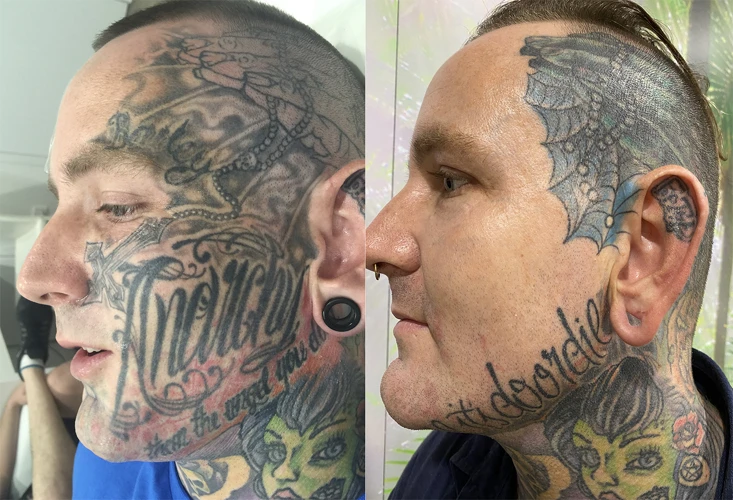
- Dermatologist: Dermatologists have extensive experience in the removal of facial tattoos and are often the most qualified and reliable professionals for the job. The procedure typically involves the use of a laser to break down the ink and allow it to be absorbed by the body.
- Cosmetic Surgeon: Cosmetic surgeons are also qualified to remove facial tattoos. They may use a combination of lasers and other technologies, such as dermabrasion, to remove the ink.
- Plastic Surgeon: Plastic surgeons are also qualified to remove facial tattoos, however, they may not have the same level of expertise as dermatologists and cosmetic surgeons.
- Tattoo Removal Specialist: Tattoo removal specialists are experienced in the removal of tattoos on the face, and may offer more specialized services than other professionals.
In general, it is important to consult a professional before attempting to remove a facial tattoo. Professional removal is typically safer and more effective than do-it-yourself methods. Additionally, it is important to consider the cost of professional removal, as it may be more expensive than other methods.
Preparing for Removal
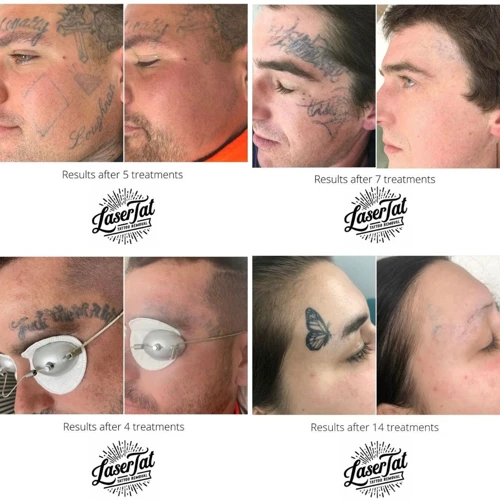
Research
Before attempting to remove a face tattoo, it is important to research the process. Understand the risks, the potential side-effects, and the cost. Make sure you understand what type of removal procedure is best for your particular tattoo and skin type. It is also important to find out if the tattoo artist who did your tattoo is experienced in the removal process.
Choosing a Professional
When choosing a professional for tattoo removal, it is important to look for someone who is experienced in the process. Ask for referrals from friends or family who have had their tattoos removed. Research reviews online, and make sure the professional has a good reputation. It is also important to find out if the professional is certified and has the necessary qualifications to safely remove your tattoo.
Methods of Removal
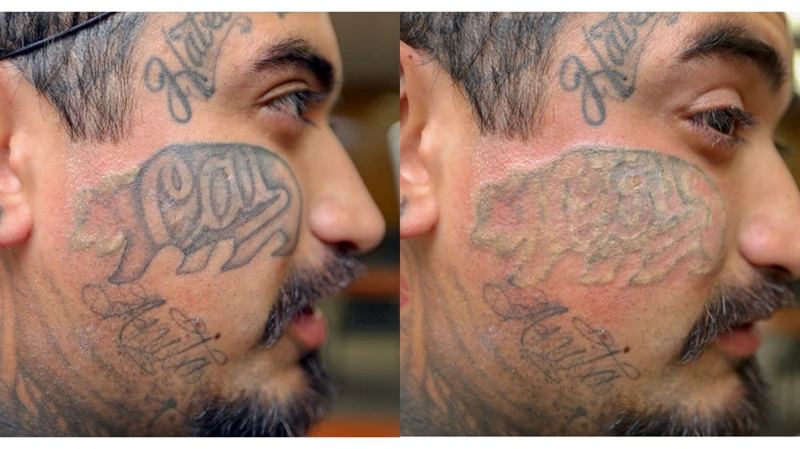
Laser Surgery
Laser Surgery is a popular method for removing facial tattoos. This procedure uses a laser to break down the ink particles in the tattoo, allowing them to be absorbed by the body. It is usually done in a series of sessions, with each session lasting around 30 minutes.
Salabrasion
Salabrasion is an older method of removing tattoos. It involves using a salt solution to scrape off the top layers of the skin, which then allows the tattoo to be removed. This method is not recommended for facial tattoos, as it can cause scarring and other complications.
Intense Pulsed Light Therapy
Intense Pulsed Light Therapy (IPL) is a newer method of tattoo removal. It involves using a high-intensity light to break down the ink particles in the tattoo, allowing them to be absorbed by the body. This method is less invasive than laser surgery and can be used on any part of the body.
Excision
Excision is a more extreme method of tattoo removal. It involves surgically cutting out the tattooed area and stitching the wound closed. This method is only recommended in extreme cases, as it can cause scarring and other complications.
Aftercare
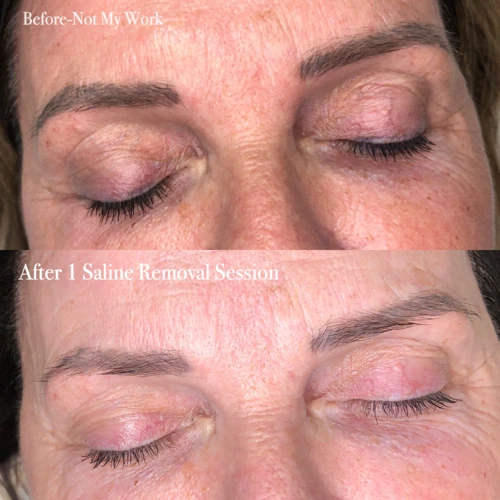
Cleaning
The tattoo removal process requires proper aftercare to ensure a successful outcome. After the procedure, the area should be gently washed with a mild soap and lightly patted dry with a clean cloth. It is important to avoid scrubbing the area as it can cause irritation and inflammation. It is also important to keep the area clean to help prevent infection.
Protecting the Skin
It is important to protect the treated area from sun exposure for at least two weeks following the procedure. Sun exposure can cause the area to become inflamed and can impede the healing process. The use of sunscreen with a SPF of 30 or higher is recommended. Additionally, the area should be kept clean and dry to promote healing.
Pros and Cons of Removal
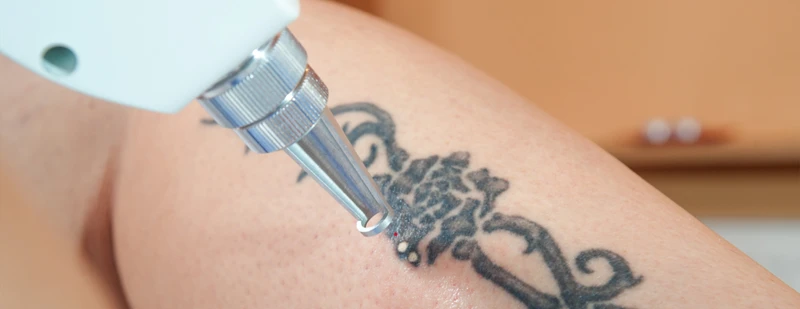
| Pros | Cons |
|---|---|
|
|
Cost of Removal
The cost of removing a face tattoo varies depending on size and complexity, as well as the method used. Laser tattoo removal is the most common and preferred method used for removing face tattoos. Laser treatments can range from $200 to $500 per session, with multiple sessions typically required for complete removal. Surgical tattoo removal is also an option, but it is much more expensive, with a cost of around $1,000 to $2,500 per session, which also requires multiple treatments.
Dermal abrasion is an alternative method that removes the top layer of skin with a spinning abrasive wheel, but it can cause permanent scarring and is not recommended for face tattoo removal.
Cover-ups are another option, but they require skill and expertise, and can cost up to $400 depending on size and design.
Frequently Asked Questions
What are the Potential Risks of Face Tattoo Removal?
Face tattoo removal comes with certain risks, such as skin discolouration, scarring, infection, and even nerve damage. It is important to discuss any potential risks with your doctor before proceeding with the removal. Laser treatments may cause damage to the surrounding skin, leaving it discoloured or even permanently scarred. Infection is another risk, as the open wound could be susceptible to germs. Additionally, there is a risk of nerve damage, as laser treatments can affect the nerves underneath the skin.
What Methods are Available for Face Tattoo Removal?
The most common methods of face tattoo removal are laser tattoo removal and dermabrasion. Laser tattoo removal uses a high-intensity light to break up and fade the tattoo ink, while dermabrasion uses a diamond-tipped wand to physically scrape off the top layers of the skin to remove the tattoo. Both procedures require multiple sessions and can be painful, so it is important to consult a professional to determine the best method for your particular tattoo. Other options include cryosurgery and topical creams, but these methods may not be as effective.
How Much Does it Cost to Remove a Face Tattoo?
Removing a face tattoo is a costly process. Depending on the size, color, location, and the number of treatments required, the cost of removing a face tattoo can range from hundreds to thousands of dollars.
- Laser removal: The average cost of laser removal is $200 to $500 per session.
- Dermabrasion: Dermabrasion is a surgical procedure that removes the outer layers of the skin, and can cost between $1,000 and $4,000.
- Surgical excision: This procedure involves cutting out the tattoo and stitching the skin closed, and can cost between $2,000 and $3,000.
The cost of removing a face tattoo will depend on the size and complexity of the tattoo, as well as the number of treatments required. It is important to consult with a qualified professional to find out what the cost will be for your specific situation.
How long does the face tattoo removal process take?
The face tattoo removal process can take anywhere from 2 to 6 months depending on the size, type, and color of the tattoo. It is important to remember that the removal process will require multiple treatments for complete removal. Each treatment session will most likely be spaced 4-6 weeks apart. The laser tattoo removal process will be more effective if the tattoo was done by a professional. If the tattoo was done by an amateur, the process will take longer.
Are there any non-invasive alternatives to face tattoo removal?
Laser Tattoo Removal: Laser tattoo removal is a safe and effective non-invasive alternative to face tattoo removal. Laser treatment works by breaking down the ink particles in the tattoo using a high-intensity beam of light. The light is absorbed by the ink particles, which then break down into smaller particles and are eventually removed by the body’s natural processes. Laser treatment is generally considered to be the most effective way to remove a face tattoo.
Dermabrasion: Dermabrasion is another non-invasive alternative to face tattoo removal. This procedure involves using a specialized device to sand down the top layers of the skin. This can help to reduce the appearance of the tattoo, but it is not a permanent solution.
Chemical Peels: Chemical peels are another non-invasive alternative to face tattoo removal. Chemical peels use a solution to remove the top layers of the skin, which can help to reduce the appearance of the tattoo. However, this is not a permanent solution.
Surgical Excision: Surgical excision is a more invasive method of face tattoo removal. It involves removing the tattooed area of skin using a scalpel. This is a permanent solution, but it comes with some risks, such as infection and scarring.
Conclusion
Removing a face tattoo is a long and involved process. While it is not impossible to erase the ink, it requires patience and dedication. A combination of laser treatments and topical creams can help lighten and fade the tattoo, but it may take multiple treatments and a few months for the ink to completely disappear. It is important to understand the risks associated with each treatment option and to select a qualified professional for the job. With a little patience and care, you can successfully remove a face tattoo and restore your skin.